in the code below I am trying to figure out the best way to share data from the "Data_Class" Class to the "Tab_2" Class. Specifically I am trying to get the values from "Data_Class" in tab1 to fill in the QLineEdit in tab2 when the buttons are clicked. I have tried using signals and sending direct to the "Tab_2" class as well but the best I can get is the values to print out in "Tab_2" but not fill the QLineEdit.
In the "MainWindow" Class I build and seperate the data and then embed "Data_Class" using FlowLayout while sending the data to "Data_Class" to create the buttons and also set the values to them but now I can't get the data sent over to "Tab_2" Class.
Also, the signal in "Data_Class" doesn't work, I just left it in anyway.
Does anyone know what I should do to receive the values properly or have any suggestions? Thanks.
import functools
import sys
from PyQt5.QtCore import pyqtSignal, QSize, QRect, Qt, QPoint
from PyQt5.QtWidgets import QLineEdit, QPushButton,QVBoxLayout, QScrollArea, QWidget, \
QApplication, QTabWidget, QStyle, QSizePolicy, QLayout
class Data_Class(QWidget):
data_Signal = pyqtSignal(str)
def __init__(self, item_num=None, item_data=None):
super(Data_Class, self).__init__()
self.tab_2 = Tab_2
self.num = item_num
self.dat = item_data
self.setFixedWidth(150)
self.layout = QVBoxLayout()
self.btn = QPushButton()
self.btn.setText(str(self.num))
self.layout.addWidget(self.btn)
self.setLayout(self.layout)
self.btn_click = functools.partial(self.set_btns, btn_data=self.dat)
self.btn.clicked.connect(self.btn_click)
def set_btns(self, btn_data):
print(btn_data)
self.data_Signal.emit(btn_data)
class MainWindow(QWidget):
def __init__(self):
super(MainWindow, self).__init__()
self.resize(368,315)
self.vbox = QVBoxLayout()
self.tabWidget = QTabWidget()
self.tabWidget.setTabPosition(QTabWidget.North)
self.vbox.addWidget(self.tabWidget)
self.tab1 = QWidget()
self.tabWidget.addTab(self.tab1, ("tab1"))
self.tab2 = QWidget()
self.tabWidget.addTab(self.tab2, ("tab2"))
self.layout1 = QVBoxLayout()
self.layout2 = QVBoxLayout()
self.tab1.setLayout(self.layout1)
self.tab2.setLayout(self.layout2)
self.scrollarea = QScrollArea(self)
self.scrollarea.setWidgetResizable(True)
self.widgets = QWidget()
self.Layout = FlowLayout(self.widgets) ##############FlowLayout
self.scrollarea.setWidget(self.widgets)
self.layout1.addWidget(self.scrollarea)
self.layout2.addWidget(Tab_2(self))
self.setLayout(self.vbox)
self.items =[]
self.extract()
def extract(self):
mydict = {'num': 1, 'data': 'data1'},{'num': 2, 'data': 'data2'}, {'num': 3, 'data': 'data3'}, \
{'num': 4, 'data': 'data4'},{'num': 5, 'data': 'data5'},{'num': 6, 'data': 'data6'}, \
{'num': 7, 'data': 'data7'}, {'num': 8, 'data': 'data8'}, {'num': 9, 'data': 'data9'}, \
{'num': 10, 'data': 'data10'}, {'num': 11, 'data': 'data11'}, {'num': 12, 'data': 'data12'}
self.items[:] = mydict
for item in self.items:
self.add_btns(item)
def add_btns(self, item):
layout = self.Layout ##################FlowLayout
item_num = item['num']
item_data = item['data']
widget = Data_Class(item_num, item_data)
layout.addWidget(widget)
class Tab_2(QWidget):
def __init__(self, parent=None):
super(Tab_2, self).__init__(parent)
self.data_class = Data_Class
self.vert_layout = QVBoxLayout(self)
self.line_edit = QLineEdit()
self.vert_layout.addWidget(self.line_edit)
self.setLayout(self.vert_layout)
self.data_class(self).data_Signal.connect(self.set_line_edit)
def set_line_edit(self, btn_data):
print(btn_data)
self.line_edit.setText(btn_data)
class FlowLayout(QLayout):
def __init__(self, parent=None, margin=-0, hspacing=-0, vspacing=-0):
super(FlowLayout, self).__init__(parent)
self._hspacing = hspacing
self._vspacing = vspacing
self._items = []
self.setContentsMargins(margin, margin, margin, margin)
def __del__(self):
del self._items[:]
def addItem(self, item):
self._items.append(item)
def horizontalSpacing(self):
if self._hspacing >= 0:
return self._hspacing
else:
return self.smartSpacing(
QStyle.PM_LayoutHorizontalSpacing)
def verticalSpacing(self):
if self._vspacing >= 0:
return self._vspacing
else:
return self.smartSpacing(
QStyle.PM_LayoutVerticalSpacing)
def count(self):
return len(self._items)
def itemAt(self, index):
if 0 <= index < len(self._items):
return self._items[index]
def takeAt(self, index):
if 0 <= index < len(self._items):
return self._items.pop(index)
def expandingDirections(self):
return Qt.Orientations(0)
def hasHeightForWidth(self):
return True
def heightForWidth(self, width):
return self.doLayout(QRect(0, 0, width, 0), True)
def setGeometry(self, rect):
super(FlowLayout, self).setGeometry(rect)
self.doLayout(rect, False)
def sizeHint(self):
return self.minimumSize()
def minimumSize(self):
size = QSize()
for item in self._items:
size = size.expandedTo(item.minimumSize())
left, top, right, bottom = self.getContentsMargins()
size += QSize(left + right, top + bottom)
return size
def doLayout(self, rect, testonly):
left, top, right, bottom = self.getContentsMargins()
effective = rect.adjusted(+left, +top, -right, -bottom)
x = effective.x()
y = effective.y()
lineheight = 0
for item in self._items:
widget = item.widget()
hspace = self.horizontalSpacing()
if hspace == -1:
hspace = widget.style().layoutSpacing(
QSizePolicy.PushButton,
QSizePolicy.PushButton, Qt.Horizontal)
vspace = self.verticalSpacing()
if vspace == -1:
vspace = widget.style().layoutSpacing(
QSizePolicy.PushButton,
QSizePolicy.PushButton, Qt.Vertical)
nextX = x + item.sizeHint().width() + hspace
if nextX - hspace > effective.right() and lineheight > 0:
x = effective.x()
y = y + lineheight + vspace
nextX = x + item.sizeHint().width() + hspace
lineheight = 0
if not testonly:
item.setGeometry(
QRect(QPoint(x, y), item.sizeHint()))
x = nextX
lineheight = max(lineheight, item.sizeHint().height())
return y + lineheight - rect.y() + bottom
def smartSpacing(self, pm):
parent = self.parent()
if parent is None:
return -1
elif parent.isWidgetType():
return parent.style().pixelMetric(pm, None, parent)
else:
return parent.spacing()
if __name__ == '__main__':
app = QApplication(sys.argv)
wnd = MainWindow()
wnd.show()
app.exec_()
